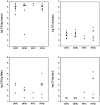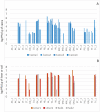Broiler farming practices using new or re-used bedding, inclusive of free-range, have no impact on Campylobacter levels, species diversity, Campylobacter community profiles and Campylobacter bacteriophages
- PMID: 38525040
- PMCID: PMC10955168
- DOI: 10.3934/microbiol.2024002
Broiler farming practices using new or re-used bedding, inclusive of free-range, have no impact on Campylobacter levels, species diversity, Campylobacter community profiles and Campylobacter bacteriophages
Abstract
A multi-stage option to address food-safety can be produced by a clearer understanding of Campylobacter's persistence through the broiler production chain, its environmental niche and its interaction with bacteriophages. This study addressed Campylobacter levels, species, genotype, bacteriophage composition/ levels in caeca, litter, soil and carcasses across commercial broiler farming practices to inform on-farm management, including interventions. Broilers were sequentially collected as per company slaughter schedules over two-years from 17 farms, which represented four commercially adopted farming practices, prior to the final bird removal (days 39-53). The practices were conventional full clean-out, conventional litter re-use, free-range-full cleanout and free-range-litter re-use. Caeca, litter and soil collected on-farm, and representative carcases collected at the processing plant, were tested for Campylobacter levels, species dominance and Campylobacter bacteriophages. General community profiling via denaturing gradient gel electrophoresis of the flaA gene was used to establish the population relationships between various farming practices on representative Campylobacter isolates. The farming practice choices did not influence the high caeca Campylobacter levels (log 7.5 to log 8.5 CFU/g), the carcass levels (log 2.5 to log 3.2 CFU/carcass), the C. jejuni/C. coli dominance and the on-farm bacteriophage presence/levels. A principal coordinate analysis of the flaA distribution for farm and litter practices showed strong separation but no obvious farming practice related grouping of Campylobacter. Bacteriophages originated from select farms, were not practice-dependent, and were detected in the environment (litter) only if present in the birds (caeca). This multifaceted study showed no influence of farming practices on on-farm Campylobacter dynamics. The significance of this study means that a unified on-farm risk-management could be adopted irrespective of commercial practice choices to collectively address caeca Campylobacter levels, as well as the potential to include Campylobacter bacteriophage biocontrol. The impact of this study means that there are no constraints in re-using bedding or adopting free-range farming, thus contributing to environmentally sustainable (re-use) and emerging (free-range) broiler farming choices.
Keywords: Campylobacter; bacteriophages; broiler; free-range; litter; re-use.
© 2024 the Author(s), licensee AIMS Press.
Conflict of interest statement
Conflict of interest: The authors declare no conflict of interest.
Figures







Similar articles
-
On-farm Campylobacter and Escherichia coli in commercial broiler chickens: Re-used bedding does not influence Campylobacter emergence and levels across sequential farming cycles.Poult Sci. 2016 May;95(5):1105-15. doi: 10.3382/ps/pew003. Epub 2016 Feb 16. Poult Sci. 2016. PMID: 26908887 Free PMC article.
-
Prevalence, genotypic diversity and detection of virulence genes in thermotolerant Campylobacter at different stages of the poultry meat supply chain.Int J Food Microbiol. 2020 Aug 2;326:108641. doi: 10.1016/j.ijfoodmicro.2020.108641. Epub 2020 Apr 25. Int J Food Microbiol. 2020. PMID: 32371295
-
Uncovering changes in microbiome profiles across commercial and backyard poultry farming systems.Microbiol Spectr. 2023 Aug 21;11(5):e0168223. doi: 10.1128/spectrum.01682-23. Online ahead of print. Microbiol Spectr. 2023. PMID: 37607066 Free PMC article.
-
Investigation of Campylobacter colonization in three Australian commercial free-range broiler farms.Poult Sci. 2021 Mar;100(3):100891. doi: 10.1016/j.psj.2020.12.004. Epub 2020 Dec 10. Poult Sci. 2021. PMID: 33516467 Free PMC article.
-
Application of Bacteriophages to Limit Campylobacter in Poultry Production.Front Microbiol. 2022 Jan 5;12:458721. doi: 10.3389/fmicb.2021.458721. eCollection 2021. Front Microbiol. 2022. PMID: 35069459 Free PMC article. Review.
References
-
- Runge GA, Blackall PJ, Casey KD. Chicken litter issues associated with sourcing and use. Canberra: Rural Industries Research and Development Corporation; 2007.
-
- Pepper CM, Dunlop MW. An industry survey on litter management and re-use practices of Australian meat chicken growers. Animal Prod Sci. 2022;62:401–408. doi: 10.1071/AN21222. - DOI
-
- Chinivasagam HN, Estella W, Rodrigues H, et al. Re-used or new bedding are not drivers of Salmonella levels and serovar emergence in commercially farmed broilers in Australia. Front Sustainable Food Syst. 2022;6:816181. doi: 10.3389/fsufs.2022.816181. - DOI
-
- Barker KJ, Coufal CD, Purswell JL, et al. In-house windrowing of a commercial broiler farm during the summer months and its effect on litter composition. J Appl Poult Res. 2011;20:168–180. doi: 10.3382/japr.2010-00242. - DOI
LinkOut - more resources
Full Text Sources
Molecular Biology Databases
